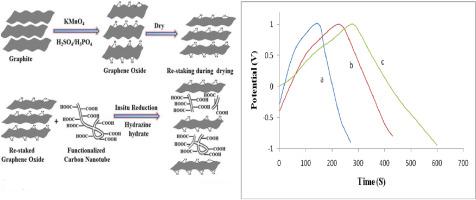当前位置:
X-MOL 学术
›
Mater. Chem. Phys.
›
论文详情
Our official English website, www.x-mol.net, welcomes your
feedback! (Note: you will need to create a separate account there.)
High- performance aqueous electrolyte based supercapacitor of carboxylic acid functionalized carbon-nanotubes and graphene nano composite
Materials Chemistry and Physics ( IF 4.3 ) Pub Date : 2021-01-01 , DOI: 10.1016/j.matchemphys.2020.123786 Pranjal Saikia , Kaushik Dutta , Ankur Kanti Guha , S.K. Dolui , Pranjit Barman , Lakhya Jyoti Borthakur
Materials Chemistry and Physics ( IF 4.3 ) Pub Date : 2021-01-01 , DOI: 10.1016/j.matchemphys.2020.123786 Pranjal Saikia , Kaushik Dutta , Ankur Kanti Guha , S.K. Dolui , Pranjit Barman , Lakhya Jyoti Borthakur

|
Abstract High specific capacitance of supercapacitors is the most prominent factor for its implementation in industrial use. However various methods has been employed to intensify the specific capacitance of supercapacitors by fabricating electrodes using graphene composite as active electrode material. However those methods have been able to attain the desired specific capacitance of the supercapacitors but there still remains some disadvantageous factors that act as hurdles for their implementation in practical field. In this work the synthesis and supercapacitor electrode fabrication of carboxylic acid functionalized carbon nanotubes/graphene composite (rGO/FCNT) has been reported without destroying the 2D sheets structures of reduced graphene oxide sheets. The carboxylic functionalities were introduced into the surface of the carbon nanotubes by treatment with H2SO4/HNO3 mixture. The final composites were synthesized by in-situ reduction of graphene oxide (GO) in presence of functionalized carbon nanotubes by the addition of hydrazine hydrate. Supercapacitor electrodes were fabricated using these composites where stainless steel plates of 1 cm2 area were used as current collectors. The materials were characterized by FTIR, Raman Spectroscopy, Scanning Electron Microscopy (SEM), X-ray photo electron spectroscopy (XPS) and XRD analysis. The surface area of the composite was determined by BET isotherm analysis. The electrochemical properties of the electrodes were evaluated by cyclic voltammetry (CV), galvenostatic charge discharge study and impedance spectroscopy. The material shows a specific capacitance of 302 F/g at a current density of 1 A/g. The newly prepared composite hold an optimistic potential to be used as electrode material in energy storage devices. The inter planer distance between the graphene nanosheets and the nature of interaction between graphene and functionalized carbon nanotubes were theoretically studied by Density Functional Theory (DFT) study.
中文翻译:

基于羧酸功能化碳纳米管和石墨烯纳米复合材料的高性能水性电解质超级电容器
摘要 超级电容器的高比电容是其在工业应用中实现的最突出的因素。然而,通过使用石墨烯复合材料作为活性电极材料制造电极,已经采用了各种方法来增强超级电容器的比电容。然而,这些方法已经能够获得所需的超级电容器比电容,但仍然存在一些不利因素,阻碍了它们在实际领域的实施。在这项工作中,已经报道了羧酸官能化碳纳米管/石墨烯复合材料(rGO/FCNT)的合成和超级电容器电极制造,而不会破坏还原氧化石墨烯片的二维片结构。通过用 H2SO4/HNO3 混合物处理,将羧基官能团引入碳纳米管的表面。最终的复合材料是通过添加水合肼在官能化碳纳米管存在下原位还原氧化石墨烯(GO)合成的。使用这些复合材料制造超级电容器电极,其中 1 cm2 面积的不锈钢板用作集电器。通过FTIR、拉曼光谱、扫描电子显微镜(SEM)、X射线光电子能谱(XPS)和XRD分析对材料进行表征。通过BET等温线分析确定复合材料的表面积。通过循环伏安法 (CV)、恒电流充电放电研究和阻抗谱评估电极的电化学性能。该材料在 1 A/g 的电流密度下显示出 302 F/g 的比电容。新制备的复合材料具有用作储能装置电极材料的乐观潜力。通过密度泛函理论 (DFT) 研究,从理论上研究了石墨烯纳米片之间的面间距以及石墨烯与功能化碳纳米管之间相互作用的性质。
更新日期:2021-01-01
中文翻译:

基于羧酸功能化碳纳米管和石墨烯纳米复合材料的高性能水性电解质超级电容器
摘要 超级电容器的高比电容是其在工业应用中实现的最突出的因素。然而,通过使用石墨烯复合材料作为活性电极材料制造电极,已经采用了各种方法来增强超级电容器的比电容。然而,这些方法已经能够获得所需的超级电容器比电容,但仍然存在一些不利因素,阻碍了它们在实际领域的实施。在这项工作中,已经报道了羧酸官能化碳纳米管/石墨烯复合材料(rGO/FCNT)的合成和超级电容器电极制造,而不会破坏还原氧化石墨烯片的二维片结构。通过用 H2SO4/HNO3 混合物处理,将羧基官能团引入碳纳米管的表面。最终的复合材料是通过添加水合肼在官能化碳纳米管存在下原位还原氧化石墨烯(GO)合成的。使用这些复合材料制造超级电容器电极,其中 1 cm2 面积的不锈钢板用作集电器。通过FTIR、拉曼光谱、扫描电子显微镜(SEM)、X射线光电子能谱(XPS)和XRD分析对材料进行表征。通过BET等温线分析确定复合材料的表面积。通过循环伏安法 (CV)、恒电流充电放电研究和阻抗谱评估电极的电化学性能。该材料在 1 A/g 的电流密度下显示出 302 F/g 的比电容。新制备的复合材料具有用作储能装置电极材料的乐观潜力。通过密度泛函理论 (DFT) 研究,从理论上研究了石墨烯纳米片之间的面间距以及石墨烯与功能化碳纳米管之间相互作用的性质。











































 京公网安备 11010802027423号
京公网安备 11010802027423号